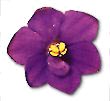|
|

|
|

"Such a starved bank of moss Till, that May-morn,
Blue ran the flash across;
Violets were born!"
- Robert Browning, The Two Poets of Croisic

Napoleon was a devout fan of the violet: when he married Josephine, she wore violets, and on every wedding anniversary he sent her a violet bouquet. In 1814, before leaving for his exile in St. Helena, Napoleon asked to visit Josephine's tomb. There he picked the violets that were found in a locket around his neck when he died. The French Bonapartists thus chose the violet as their emblem, and Napoleon was nicknamed "Corporal Violet."
Greek legend tells of a nymph named Io, who was beloved by Zeus. To hide her from Hera, his wife, Zeus changed Io into a white cow. When Io wept over the taste and texture of the coarse grass, Zeus changed her tears into dainty, sweet-smelling violets only she was permitted to eat. Roman myth tells a different story, one of lovely maids of antiquity who became the victims of Venus' wrath when Cupid judged them more beautiful than her. In her jealous fury, Venus beat the maidens until they became blue, and thus turned into violets.
To dream of violets is a promise of advancement in life. It is said that a garland of violets worn about the head prevents dizziness. They are considered a good luck gift to any woman in any season, but where violets bloom in autumn, epidemics will follow within the year.
Violets are a symbol of faithfulness. Blue violets say "I'll always be true" and signify constancy; white violets depict modesty, or the desire to "take a chance on happiness"; and yellow violets convey modest worth.